
FAIR is a non-profit organization dedicated to providing well-documented answers to criticisms of the doctrine, practice, and history of The Church of Jesus Christ of Latter-day Saints.
The Book of Mormon contains 345 names— 86 of which have to do with geography. The theory, proposed by Vernal Holley and posted by Mazeministries, is that 28 of these names (those that describe geographic locations) were derived by Joseph Smith by looking at the names of places in the surrounding region, then altering the names slightly to create a map of Book of Mormon lands.
Rather than compare to "modern maps" and "modern place names" as Holley indicated that he did, we have made an attempt to locate these places on maps from the 1800s, which could have been available to Joseph Smith. When such a comparison is made, it becomes evident that Holley has included names of places which didn't even exist in Joseph Smith's time.
We list the correspondences below. We believe it might be helpful for the reader to, along with their appraisal of the names below, see the work done in the Book of Mormon Onomasticon Project which details the linguistic connections of these names to authentic Hebraistic and Egyptian patterns as positive evidence against this claim.
The following correspondences are listed. In order to obtain this list of parallels, a huge geographical area must be scanned: Five states and two Canadian provinces yield this list of parallels, and it gets even smaller when one actually tries to locate many of these places on a map. In the list below,
In the area indicated on the Holley map, modern maps show that there is a small, unincorporated community called Centerville, also known as Alma, in Tyler County, West Virginia, United States. Coordinates: 39°25′55″N 80°50′24″W. However, when we view the 1822 map of Virginia, we cannot find the name "Alma" anywhere.
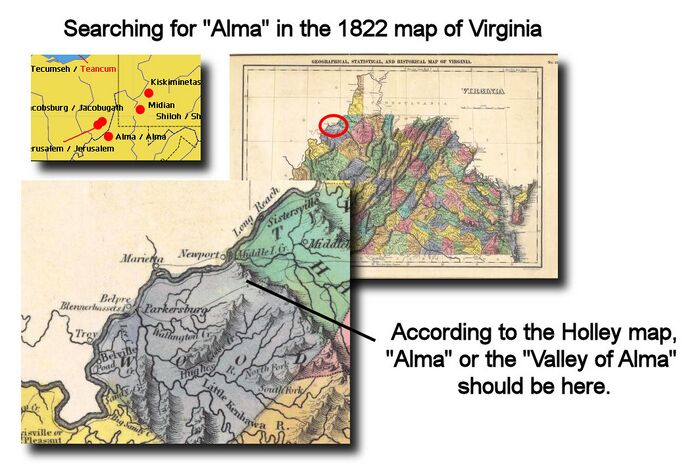
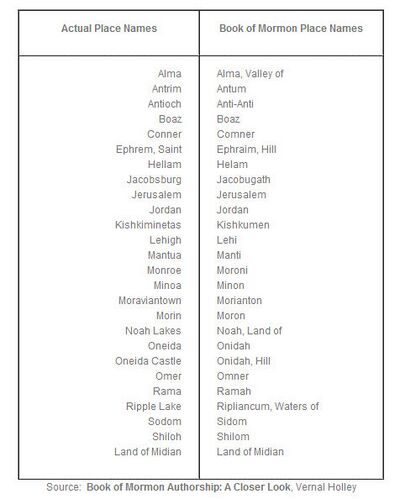
Another reviewer of this criticism wrote:
Alma, Allegany County, New York, is often given as a viable alternative, but it doesn’t work. The community was settled in the early 1830s, and at the time went by the names Honeoye, Honeoye Corners, or Shongo. (There are various theories for how it later got the name Alma.)[1]
More information regarding the name "Alma" can be found here.
"Antrim Township" is located in Franklin County, Pennsylvania. It was named after County Antrim in Northern Ireland. The township was organized in 1741.
Yet, how close is the name? There remains substantial difference.
More information on the name "Antum" may be found here
The name "Anti-Anti" doesn't appear in the Book of Mormon, nor does the biblical name "Antioch." This is most likely a typo as the name Ani-anti does. Other names proposed to match seem circumstantial.
Antioch, Monroe Country, Ohio was not founded until 1837. Antioch, Mineral County, West Virginia was not given that name until 1880.
More information on the name "Ani-Anti" may be found here.
The name "Boaz" is from the Bible. Joseph would not have needed to look at a map for this one, unless one accepts Holley's assertion that the Holley map is supposed to show the geographical locations of Book of Mormon places.
Another reviewer of this criticism added:
The only option in the Great Lakes region is Boaz, Wood County, West Virginia. Wikipedia explains, “The community was named in 1878 by the United States Post Office Department, which selected from three names suggested by a resident named William Johnson: ‘Johnson,’ ‘Ruth,’ and ‘Boaz.'”[2]
More information on the name "Boaz" may be found here.
The name "Comner" doesn't appear in the Book of Mormon. The name "Comnor" does, in Ether 14꞉28. Of course, "Comnor" doesn't match "Conner" quite as closely in spelling. We cannot find "Conner" in either New York or Pennsylvania.
Another reviewer of this criticism wrote:
This name only appears on one map of Holley’s and it’s obviously misplaced as later maps all show the same spot as Sherbrooke. But Holley noted this was in Canada (because the Book of Mormon corollary is in “the land northward”), and there is a community named Connor in Simcoe County, Ontario. A history of the township, Adjala by Francis Vincent McDevitt and Mary Margaret Munnoch (1993), says residents requested that name in honor of their hometown in Ireland when the post office was established in 1865 (p. 149). Connor doesn’t show up on an 1853 map of the township in that book (p. 27), confirming that later date of origin.[3]
More information on the name "Comnor" may be found here.
The actual name is "Saint-Éphrem-de-Beauce, Quebec." Wikipedia shows the town being established with that name in 1866. This is 36 years after the publication of the Book of Mormon. The Book of Mormon name "Ephraim," of course, is easily found in the Bible.
More information on the name "Ephraim" may be found here.
According to their website, Hellam Township, Pennsylvania, was established in 1739.
More information on the name "Helam" may be found here.
Jacobsburg, Belmont Co., Ohio does not even show up on a 1822 map of Ohio. According to Wikipedia: "Jacobsburg was laid out in 1815. It was probably named for its founder, Jacob Calvert." Therefore, the town definitely existed prior to the publication of the Book of Mormon, but was apparently too small to appear on the 1822 map seven years later. By 1833, three years after the publication of the Book of Mormon, Jacobsberg had grown to include "one tavern, two stores, a physician, sundry mechanics, and about 120 inhabitants." [4] Jacobsburg does indeed appear on an 1831 map of Ohio (one year after the Book of Mormon was published).
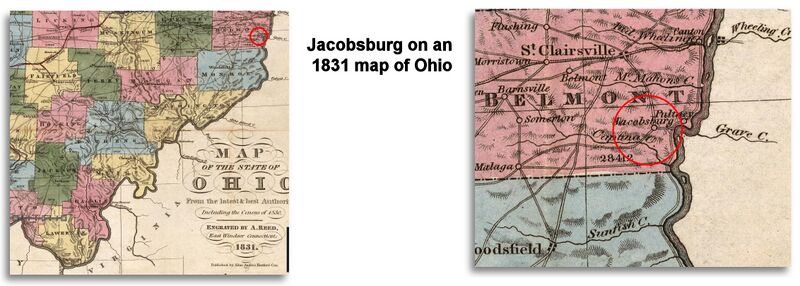
More information on the name "Jacobugath" may be found here.
Jerusalem, Monroe Co., Ohio does not even show up on a 1822 map of Ohio, nor does it show up on a 1831 map of Ohio (one year after the Book of Mormon was published). Even today the village of Jerusalem occupies only 0.2 square miles. The Holley map shows "Jerusalem" in Ohio, but we went ahead and searched for other towns named "Jerusalem." It turns out that there is a Jerusalem, New York that was established in 1789, however, it does not appear on either the 1822 map or the 1831 maps of the state of New York. The town was named after the Biblical city of Jerusalem. Besides, the name "Jerusalem" is from the Bible. Joseph would not have needed to look at a map for this one, unless one accepts Holley's assertion that the Holley map is supposed to show the geographical locations of Book of Mormon places.


More information on the name "Jerusalem" may be found here.
The village of Jordan, New York existed prior to 1819 and became an incorporated village in 1835. [6] The town of Jordan, New York was established prior to 1819, but does not appear on the 1822 map of New York. It does appear on the 1827 map (three years prior to the publication of the Book of Mormon) and the 1831 map of New York (one year after the publication of the Book of Mormon). The name "Jordan" is from the Bible. Joseph would not have needed to look at a map for this one, unless one accepts Holley's assertion that the Holley map is supposed to show the geographical locations of Book of Mormon places.

More information on the name "Jordan" may be found here.
Vernal Holley states in his book Book of Mormon Authorship, that he relies upon "modern maps" when he speculates on the name Kishkumen,
The location of the Book of Mormon city of Kishkumen is not given in the text. However. there are names similar to Kishkumen, on modern maps, in the location of Spaulding's Manuscript Story setting. [7]
Kiskiminetas Township, Armstrong County, Pennsylvania was given that name in 1832, two years after the Book of Mormon was published. From History of Armstrong County Pennsylvania, written in 1883 by Robert Walter Smith, "The petition of sundry inhabitants of Allegheny township was presented December 22, 1831, to the court of quarter sessions of this county, asking that a new township be formed out of the upper end of Allegheny township, to be called Kiskiminetas. Philip Klingensmith, John Lafferty and John McKissen were appointed viewers, who, after one continuance of their order, presented their report recommending the organization of the new township, which was approved by the court June 19, 1832." off-site Kiskiminetas River in Pennsylvania does exist prior to the town, and one would assume that it would show up on a map. In addition, the name appears as a place name on page 40 of the 1776 publication A Topographical Description of Such Parts of North America as are Contained in the (Annexed) Map of the Middle British Colonies, &c. in North America, by T. Pownhall.[8]

More information on the name "Kishkumen" may be found here.
There is indeed a "Lehigh Valley" located in Pennsylvania.
More information on the name "Lehi" and its derivatives in the Book of Mormon may be found/linked to here.
According to their website, Mantua Village, Ohio, was incorporated in 1898. This is 68 years after the publication of the Book of Mormon.
More information on the name "Manti" may be found here.
There is a town "Monroe, New York" which was named in 1808. The town does not appear on either the 1822 or the 1831 maps of New York.

More information on the name "Moroni" may be found here.
According to the Minoa town website, the town of Minoa, New York received that name in 1895. That is 60 years after the Book of Mormon was published.
More information on the name "Minon" may be found here.
Moravian Indian Reserve No. 47, Ontario, appears to have been established in 1782.
Holley made a lot of noise about the supposed similarities between Moriavan Town/Tecumseh and Morianton/Teancum. One reviewer of this criticism noted:
Most early publications and maps refer to the community as Moravian Village (see this 1826 map of Canada, for example). However, the 1819 publication The Late War (a favorite among church critics) notes it as Moravian Town (page 115).[9]
Critics tend to associate Tecumseh and Moriavian Town by means of the Late War instead of the maps. Moravian Town is more often named "Moravian Village" in the maps or "Moravian Indian Reserve" as noted above. Tecumseh is not even listed as a town until 1912 which Holley himself noted in his publication. One reviewer pointed out Tecumseth in Canada as a possible candidate. As they noted:
The name was given in 1821, and settlers arrived soon after. The township is depicted on an 1826 map of Canada. An American option is, of course, the city of Tecumseh in Lenawee County, Michigan. The city was established in 1824, and appears on many maps of the 1820s. The town is also cited in the 1825 version of the United States Official Postal Guide (page 92).[10]
Thus, Joseph would have to have either seen the names in maps and modified both a bit to get Morianton and Teancum or seen them in the Late War (or perhaps, by some weird chance, he saw one from both). The problem with the first theory is that the names would come from basically two different maps--one from the U.S. and the other from Canada. Additionally, there is no evidence that Joseph was looking at these maps prior to the publication of the Book of Mormon. The problem with the second theory is that Tecumseh and Moravian Town are separated both physically and thematically in Hunt's book (See pp 115, 118). Additionally, there is no evidence Joseph saw this work. The simplest explanation for the names would be Joseph's story.
More information on the name "Morianton" may be found here. More information on the name "Teancum" may be found here.
According to Wikipedia, Morin Township, Quebec, was formed in 1852. This would be 22 years after the Book of Mormon was published.
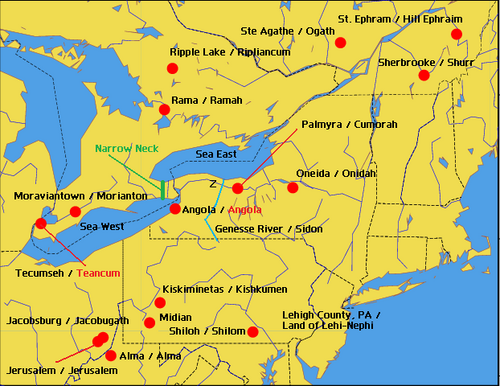
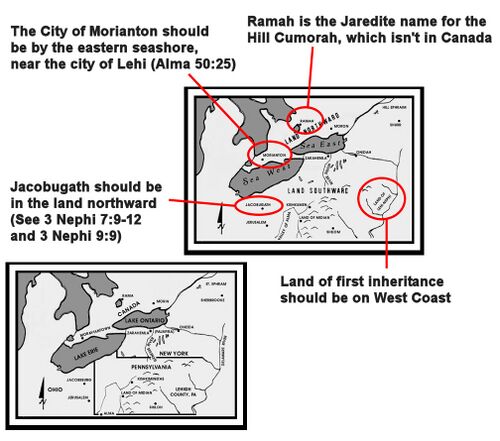
More information on the name "Moron" may be found here.
The name "Noah" is from the Bible. Joseph would not have needed to look at a map for this one, unless one accepts Holley's assertion that the Holley map is supposed to show the geographical locations of Book of Mormon places.
Another reviewer of this criticism noted:
These don’t show up on any of Holley’s maps, but the only two options I can find are Lake Noah in Summit County, Ohio, and Lake Noah in St. Joseph County, Michigan. Unfortunately for Holley, Lake Noah in Summit County is not natural. It was likely made when they put in the nearby Nimisila Reservoir in 1936. An 1874 map of Green Township in Summit County shows what the area looked like before the reservoirs were put in. As for the lake in Michigan, it also seems to have been affected by human activity. On an 1872 map of Lockport Township in St. Joseph County all you see is a tiny unnamed pond on the property of a Mr. J. George Ott where Google now places Noah Lake, and it’s nowhere near the size of what maps show today.[11]
More information on the name "Noah" may be found here.
See "Oneida Castle".
Oneida Castle, New York is located at 43°4′42″N 75°38′0″W. The town has existed since the 18th century.
More information on the name "Onidah" may be found here.
We cannot find "Omer" on any modern map of Pennsylvania, New York or Canada.
More information on the name "Omner" may be found here.
Holley speculates that Joseph obtained the name "Rama" from the Rama Indian Reservation or Rama Township, noting that
"Today, south by southeast from Lake Superior (Waters of Ripliancum?), near Lake Simcoe in Ontario, Canada, is the Rama Indian Reservation, [61] located within the boundaries of Rama Township. [62] The Book of Mormon Ramah was [relatively near] the Waters of Ripliancum in the "land northward," and, similarly, the modern day Rama Indian Reservation is located [relatively near] several place names with a "Ripple" designation, in Canada (the north country)."[12]
The Rama Indian Reservation did not exist as such until 1836, when the Chippewas of Lake Simcoe and Huron were forced to move and purchased the land in Rama Township in 1836. However, the town was named in 1820 and it does appear on an 1826 map of Canada.
The name "Ramah" is listed 34 times in the Old Testament. According to the Book of Mormon Onomasticon with regard to the name "Ramah":
RAMAH is given in Ether 15:11 as the name of the hill where CORIANTUMR encamped before his final battle as well as the name of the place where MORMON hid the sacred records. Given the close association of the location with both events, the name RAMAH may well be of NEPHITE, rather than JAREDITE, origin, and may be derived from the HEBREW rāmāh, "elevation, height;"
It is significant that the Book of Mormon frames Ramah as a "hill" rather than simply a location. Thus the argument should perhaps be more about the way the name is used rather than the simple existence of it in the Book of Mormon narrative.
Holley speculated that "Waters of Ripliancum may have been Lake Superior, the largest of the five Great Lakes. On or near the north shore of Lake Superior are Ripple Bay, Ripple Creek, Ripple Reef, and Ripple Lake—names surprisingly similar to the "Waters of Ripliancum." [13] However, Ripple Lake is so small that it is difficult to locate on modern day maps, and it is one of more than 250,000 lakes in Ontario. Are we to assume that Joseph selected this one location amongst many, and then converted the name "Ripple Lake" to "Ripliancum?"
More information on the name "Ripliancum" may be found here.
The name "Sodom," of course, is well known from the Bible. That is the only context it is used in the Book of Mormon as well. It is only mentioned when Nephi quotes Isaiah (2 Nephi 13:9; Isaiah 3:9; 23:19; 13:19). Joseph would not have needed to look at a map for this one, unless one accepts Holley's assertion that the Holley map is supposed to show the geographical locations of Book of Mormon places.
More information on the name "Sidom" may be found here. More information on the name "Sidon" may be found here.
There is a Shiloh, Pennsylvania on modern maps (which Holley claimed to have relied on), however, it is a Census Designated Place (CDP) consisting of 4.2 square miles [14] that was established only for statistical purposes. As such, a town named "Shiloh" does not appear on any maps in Pennsylvania either now or on maps contemporary with Joseph Smith's time. It also should be noted that the name "Shiloh" is a biblical name.
The name "Land of Midian" is from the Bible and it is located in Egypt. Joseph would not have needed to look at a map for this one, unless one accepts Holley's assertion that the Holley map is supposed to show the geographical locations of Book of Mormon places. We are unable to locate a "Midian" or "Land of Midian" on any modern map of Pennsylvania.

FAIR is a non-profit organization dedicated to providing well-documented answers to criticisms of the doctrine, practice, and history of The Church of Jesus Christ of Latter-day Saints.
We are a volunteer organization. We invite you to give back.
Donate Now